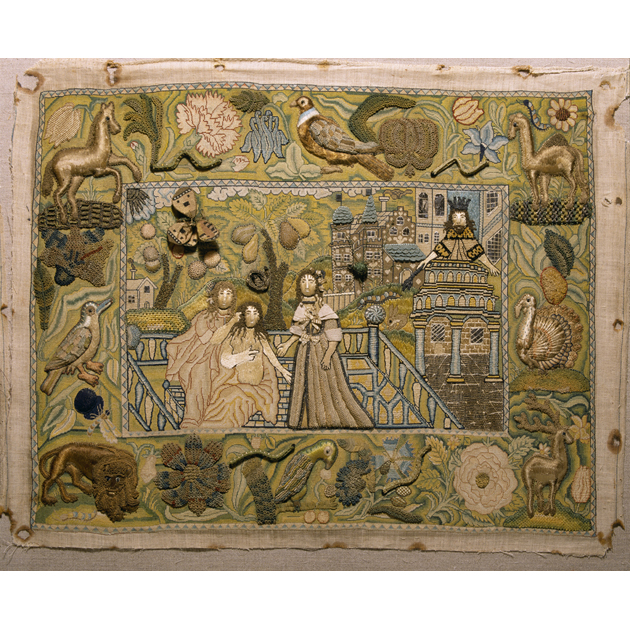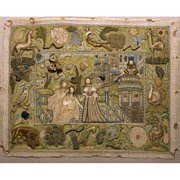Details
- Object type
embroidered panel; raised-work panel
- Title
David and Bathsheba
- Place Associated
England (place of manufacture)
- Date
circa 1630-1680
- Materials
linen, silk, metal, mica, raisedwork
- Dimensions
overall: 380 mm x 485 mm
- Description
-
Embroidered panel or raised-work panel in linen embroidered in light blue, blue, dark blue, light brown, brown, cream, light green, green, dark green, red and yellow silk and metal thread, purl, mica, straw and silver loops in raised and padded work worked in tent, Ceylon, detached-buttonhole, long and short, queen (also known as rococo) and straight stitch with couching depicting David and Bathsheba with Bathsheba seated between two female attendants, top right David watches from a balcony, set in landscape with buildings and fruit tree with butterfly and spider. Border with horse, camel, stag, lion, birds, including a turkey, flowers, including aquilegia, borage, carnation, cornflower, daffodil, foxglove, rose and tulip.
In the bottom left Bathsheba, naked except for a draped yellow cloth, sits beside a wall with a female attendant in a light brown gown on her left dressing her hair and another female attendant in a brown gown with white collar and cuffs on her right, all enclosed by a balustrade. Their faces are padded silk satin, bodies in long and short stitch and hair in over-twisted thread couched down. The first attendant and Bathsheba’s clothes are in tent stitch, the second attendant’s gown is in detached-buttonhole stitch decorated with flattened silver loops, two lengths twined together giving figure of eight effect, trimmed with narrow warp faced ribbons, with beads or silver purls. On the right is David wearing a crown and Robes of Estate with the fur worked using chenille thread and holding his sceptre stands on an arcade with further buildings behind with their turrets and roofs worked in detached buttonhole stitch and their windows with mica. In the background is the sun, a small building on the left and two fruit trees worked in long-and-short stitch, Queen stitch and tent stitch. Over the left tree is a pair of three-dimensional butterflies with brown speckled wings and straw bodies, and over the central building is a three-dimensional large green spider with round body and long legs.
Narrow inner and outer borders with zigzags in light blue and cream with a dark blue edging on either side. Wide middle border with horse, tulip, caterpillar, carnation, aquilegia, pigeon, lily, tulip, borage, caterpillar, camel, marigold, turkey, daffodil, tulip, stag, rose, caterpillar, cornflower, parrot eating berries, caterpillar, flower, foxglove, lion, butterfly, plums, bird and lily. Some motifs are worked in tent stitch and others in metal thread and raised work with coloured silk covered purl, the animals in the corners are worked in silk over padding, the four caterpillars are raised and padded work with Ceylon stitch.
The story of David and Bathsheba is from II Samuel (11:2–12). This panel shows the fateful moment King David standing in a tower of his palace sees Bathsheba, the wife of Uriah the Hittite, having a bath. David is overcome with passion for Bathsheba and arranges for Uriah to lead his army into battle. Uriah subsequently dies and after the period of mourning is over David marries Bathsheba. This was a popular subject in the 1600s. Several embroideries survive that are dervived from the engravings after Adriaen Collaert (about 1560–1618) or by Jan Sadeler I (1550–1600) in Gerard de Jode (1509–91), Thesaurus Sacrarum Historiarum Veteris Testamenti, Antwerp, 1585. However, the source of this unusual panel with its spider and butterfly settled over the subject matter has not been identified.
Provenance: William Burrell.
- Credit Line/Donor
Gifted by Sir William and Lady Burrell to the City of Glasgow, 1944
- Collection
Burrell Collection: British Embroideries
- ID Number
29.59
- Location
In storage


